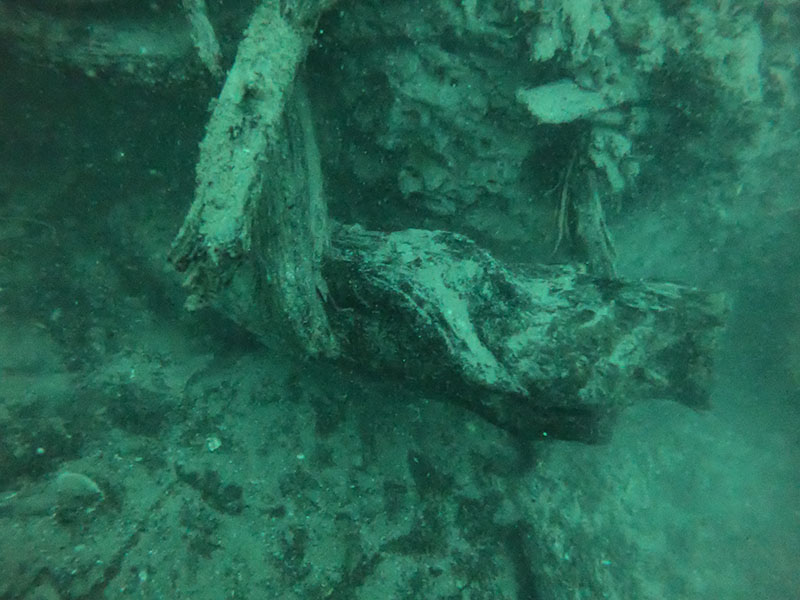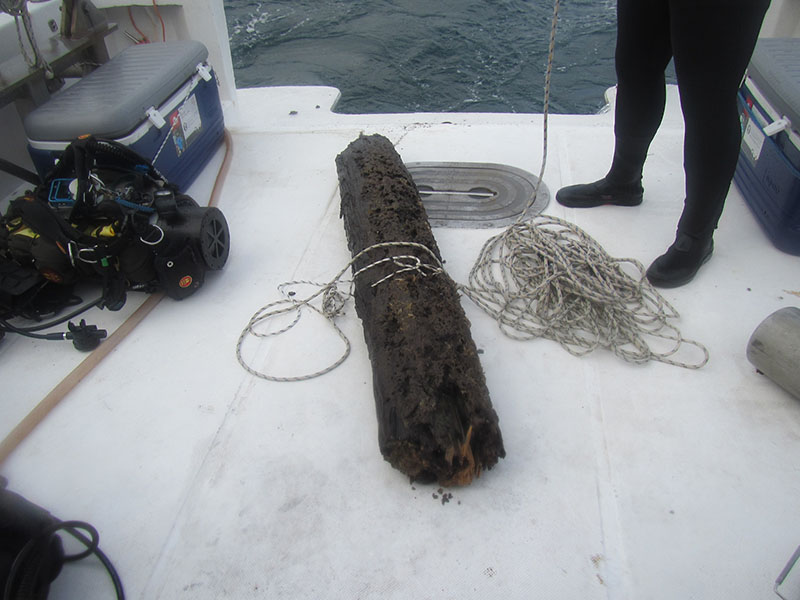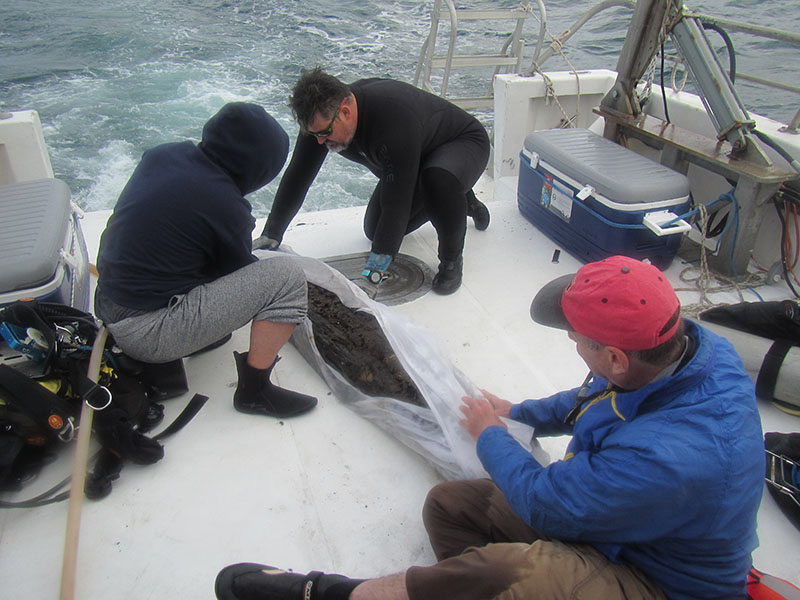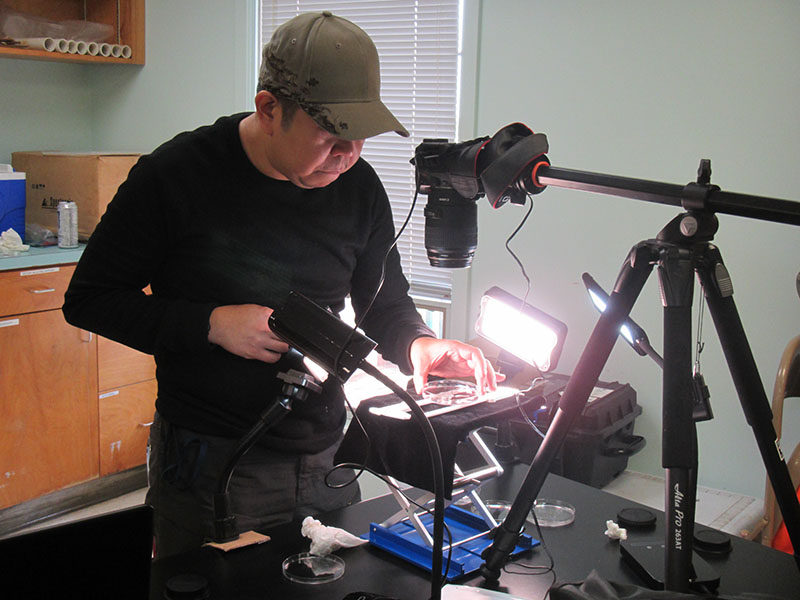
August 2020 - October 2022
Take a virtual dive into a 60,000-year-old bald cypress forest buried off the coast of Alabama. The forest, now uncovered due to storms, is being explored by a team of scientists from Northeastern University and the University of Utah, with funding from NOAA Ocean Exploration, in hopes of unlocking the forest’s secrets, including its potential to harbor new compounds for medicine and biotechnology. Video courtesy of Brian Helmuth and Northeastern University. Download larger version (mp4, 112 MB).
Nearly 60,000 years ago, a bald cypress forest flourished on the banks of a prehistoric river near the Gulf of Mexico. Over time, the massive trees grew and died, their enormous trunks falling and becoming entombed in a protective covering of peat and sediment. As sea level rose and the coastline receded, these ancient forest remains were buried beneath the sea surface off the coast of Alabama, where they remained undisturbed for millennia. Intensifying storms along the coast, however, have scoured the seafloor, beginning to expose this ancient submarine forest.
Three-dimensional structures created by pilings and wood in the ocean encourage settlement and growth of marine animals like tunicates and sponges. Many species of fish congregate in these areas, attracted by abundant food sources. Video courtesy of of Brian Helmuth. Download larger version (mp4, 27 MB).
Now, a team of scientists from Northeastern University and the University of Utah, funded by NOAA Ocean Exploration, are working to unlock the forest’s secrets, including its potential to harbor new compounds for medicine and biotechnology.

Wood from a 60,000-year-old bald cypress forest buried off the coast of Alabama was uncovered by storms. Newly exposed wood offers a unique habitat for marine organisms and creates a novel ecosystem in the Gulf of Mexico. Image courtesy of Francis Choi. Download larger version (jpg, 5.3 MB).
As demand grows for discovery of novel industrial enzymes and new medicines, researchers are increasingly looking towards the ocean. Marine animals and their symbiotic microorganisms that live on and in wood have recently been shown to be a potentially rich source for biomolecules of high biopharmaceutical and biotechnological value.
To this end, this research team is exploring the biodiversity and economic potential of the submerged forest off the Alabama coast, which provides an unusually large, biodiverse, and temporally stable wood-associated marine habitat for them to study. The team’s focus is on bacteria found in wood-eating “shipworms,” a type of clam (teredinid bivalve). These “termites of the sea” convert wood into animal tissue, forming the base of a food chain that can support a rich diversity of fish, invertebrates, and microorganisms in communities that resemble thriving coral reefs.
Ocean Genome Legacy Center Director Dan Distel carefully removes a shipworm from its burrow in wood collected in the Alabama underwater forest. Sometimes called “termites of the sea,” shipworms bore into submerged wood, eating the cellulose of the wood and creating burrows. Video courtesy of of Brian Helmuth. Download larger version (mp4, 8.9 MB).
Previous work by the research team on bacteria in shipworms has resulted in at least one antibiotic being under investigation as a drug to treat parasitic infections, and the overall biopharmaceutical potential for these bacteria is high. Drug compounds produced by symbiotic microbes are less likely to display toxicity toward animals than free-living bacteria, as these molecules have essentially been “pre-screened” by their animal hosts. They can be reproduced under lower temperatures and less harsh conditions than current industrial processes, meaning a potential cost savings for industrial applications. Additionally, the wood at the site off the Alabama coast has lain submerged and buried in a deep layer of sand and sediment for thousands of years, creating an isolated and unique habitat for discovery of unusual microbes and molecules.

Collected from an ancient cypress forest submerged in Mobile Bay, this log contains hundreds of marine organisms that either burrow into the wood or live in burrows made by other organisms. Image courtesy of Brian Helmuth. Download larger version (jpg, 3.5 MB).

Ocean Genome Legacy Center Director Dan Distel, Dive Safety Officer Grant Lockridge, and researcher Francis Choi wrap a 60,000-year-old log to keep it damp for the trip back to shore. Once on in the lab, researchers dissected the wood to discover what marine species were living inside. Image courtesy of Brian Helmuth. Download larger version (jpg, 4 MB).
In early December, the research team headed offshore of Alabama on Research Vessel E.O. Wilson to conduct the first round of field work for the project. During two days of diving, the team collected several pieces of ancient wood which they took back to the Dauphin Island Sea Lab. More than 300 animals were removed from the wood, photographed, and identified. Some were preserved as voucher specimens for future DNA analyses while others were used to create culture plates to sample for microbes.

Researcher Marvin Altamia focuses on capturing detailed voucher images of organisms collected from the Alabama submerged forest. These high-quality images capture the morphology of the marine organisms and can be used for species identifications. Image courtesy of Brian Helmuth. Download larger version (jpg, 3.6 MB).
Within 100-200 prepared culture plates, the team identified approximately 100 strains of bacteria, many of which are novel and 12 of which are already undergoing DNA sequencing for further study of their identity and their biosynthetic potential to make new drugs. Additionally, future analyses on the collected samples will allow researchers to identify any analgesic and antimicrobial compounds and hydrolytic enzymes capable of degrading the components of wood. Such enzymes have broad application in production of pulp, paper, textiles, food, animal feeds, fine chemicals, and renewable fuels.
The scientists have so far sampled only a tiny fraction of the ancient forest site, but are already gaining important insights into the ways terrestrial plant material can support unusual but highly productive marine communities. With rising sea level and increasing storm intensity, input of wood will have an ever-increasing influence on marine communities. The work being done here provides a window into the profound changes we may expect to see.
Funded through OER’s competitive grants program, this exploration project is directly connected to NOAA’s efforts strengthen the Blue Economy, which includes also maritime commerce, domestic seafood production, healthy and sustainable fisheries, coastal resilience, energy production, tourism and recreation, environmental protection, and national security.
The project will lay the groundwork for understanding and exploiting similar communities as sources of new compounds for medicine and biotechnology. To enhance the value of their exploratory efforts, the researchers are aiming to create effective tools and resources to support future discovery and education.